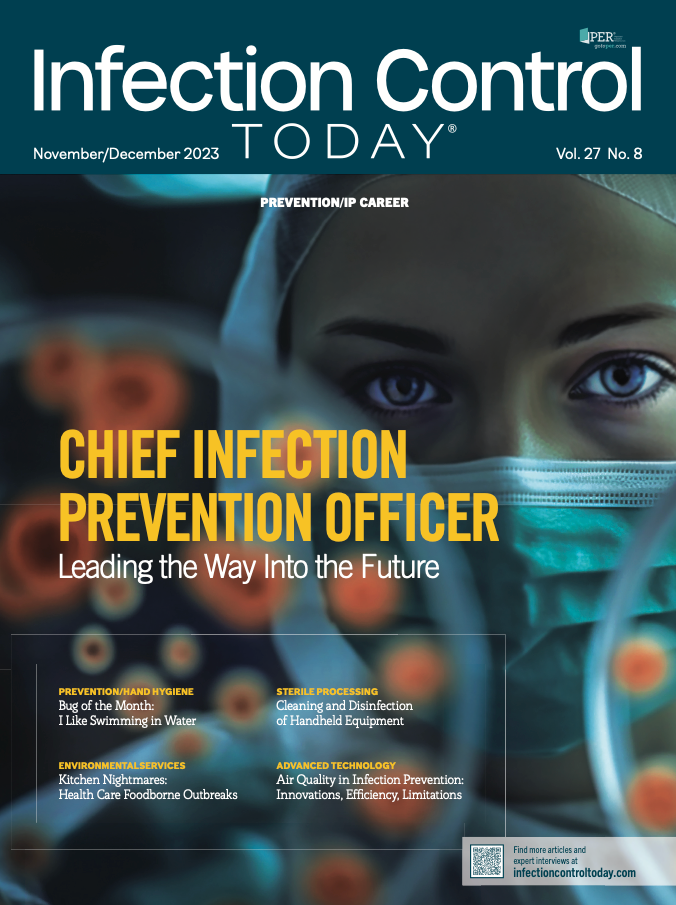Chief Infection Prevention Officer: Leading the Way Into the Future
The role and responsibility of executive-level oversight in infection prevention is growing. Expertise, determination, consistency, and sustainability bring value to reducing healthcare–associated infections, preventing harm, and supporting a safe workplace.
A woman wearing a mask and holding petri dishes.
(Adobe Stock 630899781 by Basily Merkushev)

When initially considering the question, “Should infection preventionists (IPs) have a chief infection prevention officer (CIPO) for facilities?” The simple yet loaded answer is yes. Institutionally, we have historically built in executive leadership supporting various operational roles within health care institutions. These roles include but are not limited to the chief information officer (CIO), chief nursing officer (CNO), chief medical officer (CMO), and the familiar role of the chief executive officer (CEO).
What would this CIPO role look like?
Anne Mattern, BSN, RN, CNORe, CIC, said. “Over the years, infection prevention and control [IPC] programs have changed their design to mitigate and reduce health care–acquired infections [HAIs] and acquired multidrug-resistant organisms. Research supports that HCOs have improved their culture for safe choices through up-to-date systematic reviews, standardization, monitoring of infection prevention clinical and nonclinical practices, and prioritization to reduce HAIs.1-3 However, there is room for improvement, and a new leadership role to support and prioritize IPC practices at the systemwide level is the designation of a CIPO. Armor Health, a provider of correctional health care services, invested in the correctional health care service’s first-ever CIPO to lead in IPC standards and prevent the spread of infection.4,5
Mattern, the education chair and moderator, facilitating professional development and continuing education for the Association for Professionals in Infection Control and Epidemiology (APIC) DFW (Dallas-Fort Worth) chapter, explained that a CIPO embodies a distinct role that combines the expertise of a seasoned nurse specialized in infection prevention, an infectious disease medical director, and a certified infection control practitioner. This executive position oversees and orchestrates the infection prevention and control (IPC) activities and assets within a health care organization (HCO). Additionally, the CIPO is instrumental in fostering collaboration among various entities, including hospital administration, board members, quality management, clinical microbiology, clinical engineering, nursing, materials management, and environmental services.
According to Shira Doron, MD, FIDSA, FSHEA, chief infection control officer at Tufts Medicine; a hospital epidemiologist, within the Division of Geographic Medicine and Infectious Diseases, Tufts Medical Center; and an associate professor of medicine at Tufts University School of Medicine, “Hospital epidemiologists play a vital role in orchestrating the efforts to prevent the emergence and transmission of infection within a hospital. [CIPOs]…serve in that same role at a health system level, coordinating those efforts across multiple entities and various health care settings. As a hospital epidemiologist and CIPO, I have years of formal and on-the-job training that is highly specialized at the intersection of epidemiology, infectious diseases, public health, and clinical research methods.”
Doron explained that she dives into areas that often escape the immediate purview of typical clinicians daily. These include facets such as air handling systems, disinfectant products, environmental cleaning techniques, and theories regarding behavioral change. Her primary responsibility is to employ the latest scientific evidence to develop mitigation strategies aimed at averting infections. This task is especially crucial as medical interventions become more invasive, rendering the patient population more vulnerable to infections. To successfully implement infection prevention strategies, she engages with a diverse array of departments within the hospital, ranging from environmental services (commonly known as housekeeping) to respiratory therapy, sterile processing, and even the executive suite.
“I supervise a team of IPs, specialists who conduct infection surveillance, maintain policies and procedures to prevent infection, cultivate relationships with frontline staff to educate and advocate for safe patient care, and present data to stakeholders,” Doron said.
These statements from Doron speak to me. As an IP myself, we consistently review, implement, evaluate, collaborate, and facilitate all areas within all service lines. As Doron shared, one key piece to the CIPO is the direct line of communication with the executive suite. The CIPO collaborates with other executive officers by advocating for and acting on behalf of IPs, practitioners, and subject matter experts to ensure sustainable change to benefit patient and staff safety and support well-being.
Mattern highlights that “CIPOs are appreciated for their ability to improve value, quality, innovations, and performance excellence for strategic prevention goals and programs. However, health care barriers resulting from quick changes in health care practices, economic challenges, or stressed health care workers [HCWs] can lead to a lack of support and a negative culture.6 For example, challenges to successfully implementing hand hygiene programs, novel environmental disinfection strategies, or Clostridiodes difficile improvement programs can fail due to lack of executive leadership support, poor communication, or negative workplace culture.”6
Mattern also explained that Garcia et al2 emphasized that the primary responsibility of HCOs in preventing HAIs requires a safety culture that supports positive outcomes and improves patient care.2 Similarly, Reisch and team6 suggested that effective leadership is crucial in establishing and maintaining a strong and positive culture within HCOs.5
Mattern notes that both Garcia et al2 and McAlearney et al3 list 3 conditions to be a successful CIPO. “First is the engagement and open communication of the executive staff to prioritize IPC practices among the HCO leadership, management teams, and HCWs who effect changes in practice. Second is to ensure transparency of relevant system-wide data throughout the HCO to support policies and practice changes. Third, practice leadership coaching to provide management and HCWs with ongoing feedback, ensure policies and practices are aligned, and staff education or reeducation in IP evidence-based practice are supported.”2,3
Doron added that “as hospitals and other health care entities consolidate into larger health systems, having someone responsible for infection control oversight at the system level is critical. I have been able to look at each entity under my purview and determine what is working and what is not, taking best practices from each when harmonizing policies and aligning practices. This elevates the level of excellence of every entity within our system.”
I appreciate Doron’s focus and drive to identify and pursue best practices, note opportunities for improvement, and harmonize entities in infection prevention practices. Kudos to Tufts Medical Center and other entities for successfully evaluating and implementing the CIPO role.
I contacted Patricia Jackson, RN, MA, CIC, FAPIC, the APIC 2023 president, to inquire whether health care facilities should have a CIPO. She shared that the APIC has yet to have an official position on this topic. In pursuing the ideal CIPO position, I identified a few additional leaders with a current duty title of CIPO. Within this small group scattered throughout the continental US, there are a few familiar existing titles: medical directors of infection prevention, infectious disease physicians, and nurse executives. However, most CIPOs are infectious disease physicians. Interestingly, within the past several years, we have seen growth and development in the robust expertise in infection prevention. What was thoughtfully born out of nursing is now solidified by various roles and experiences within our health care industry.
It is vitally important to highlight IPs’ diverse backgrounds. IPs hail from epidemiology, medical laboratory technology, respiratory therapy, and infectious disease pharmacy. Our field is crucially pervasive within the health care arena. Therefore, in adding to Mattern’s thoughts, the future of IP should reflect critical players and experts in infection prevention and the various specialties given APIC competency model domains and subdomains.6
Waldowski recognizes the importance of the role at the organizational level, it could also be titled VP, executive director, or CIPO. However, “It is not the title that makes the difference. The secret sauce lies within the leader’s background, knowledge, and vision to best communicate, advocate, address, and support [IPC] program activities/[IPs] throughout the organization. How you successfully lead and integrate this specialty of infection prevention and control at the top leadership level will depend on why you chose the leadership background, knowledge, and skill set in the first place.”
Therefore, drawing from all respective experiences and the CIPO above, executive director of infection prevention, and seasoned IPs, this sheds significant light on the why behind the role, regardless of the title. For continuity and sustainability, engaging other IP experts with backgrounds dissimilar from infectious disease medicine may be beneficial to generate interdisciplinary leadership. However, infectious disease medicine is a fantastic jumping off point. Having an established foundation as the role begins to gain further momentum will only strengthen the field of infection prevention.
References
- Garcia R, Barnes S, Boukidjian R, et al. Recommendations for change in infection prevention programs and practice. Am J Infect Control. 2022;50(12):1281-1295. doi:10.1016/j.ajic.2022.04.007
- McAlearney AS, Gaughan AA, DePuccio MJ, MacEwan, SR, Hebert C, Walker DM. Management practices for leaders to promote infection prevention: lessons from a qualitative study. Am J Infect Control. 2020;49(5):536-541. doi:10.1016/j.ajic.2020.09.001
- Armor Health invests in correctional healthcare’s first-ever chief infection prevention officer. Walden University. December 13, 2020. Accessed September 24, 2023. https://link.gale.com/apps/doc/A643913635/EAIM?u=minn4020&sid=ebsco&xid=f1a39033
- Riesche SK, Chiappa J, Floyd N, Ponce M. The chief nursing officer shared leadership model. Nurse Leader. 2023;21(1):31-37. doi:10.1016/j.mnl.2022.09.006
- Infection preventionist (IP) competency model. Association for Professionals in Infection Control and Epidemiology. Accessed October 1, 2023. https://apic.org/professional-practice/infection-preventionist-ip-competency-model/
- Lavin MA. Retaining and developing the IPs of Tomorrow. Infection Control Today. Accessed October 1, 2023. https://www.infectioncontroltoday.com/view/retaining-and-developing-the-ips-of-tomorrow-how-to-find-meaning-as-an-infection-preventionist
